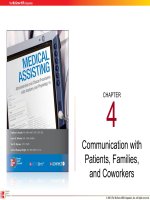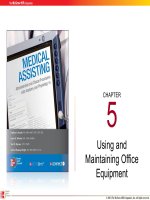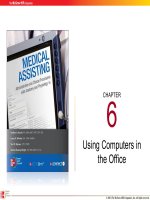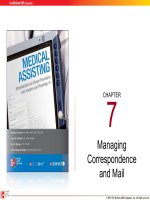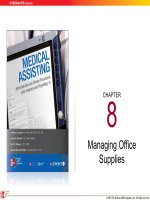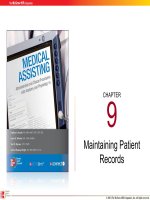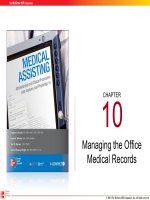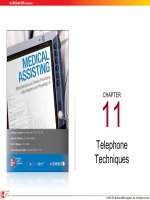Lecture Medical assisting: Administrative and clinical procedures with anatomy and physiology (4e) – Chapter 27
Bạn đang xem bản rút gọn của tài liệu. Xem và tải ngay bản đầy đủ của tài liệu tại đây (1.19 MB, 70 trang )
CHAPTER
27
The Reproductive
System
© 2011 T he McGraw -Hill Com panie s, Inc. A ll rights reserv ed.
27-2
Learning Outcomes
27.1 List the organs of the male reproductive
system and give the locations, structures,
and functions of each.
27.2 Describe how sperm cells are formed.
27.3 Describe the substances found in semen.
27.4 Describe the process of erection and
ejaculation.
© 2011 T he McGraw -Hill Com panie s, Inc. A ll rights reserv ed.
27-3
Learning Outcomes (cont.)
27.5 List the actions of testosterone.
27.6 Describe the causes, signs and symptoms,
and treatment of various disorders of the
male reproductive system.
27.7 List the organs of the female reproductive
system and give the locations, structures,
and functions of each.
27.8 Explain how ova develop.
© 2011 T he McGraw -Hill Com panie s, Inc. A ll rights reserv ed.
27-4
Learning Outcomes (cont.)
27.9
List the actions of estrogen and
progesterone.
27.10 Explain how and when ovulation occurs.
27.11 Describe what happens to an ovum after
ovulation occurs.
27.12 List the purpose and events of the
menstrual cycle.
27.13 Define menopause and explain what
causes it.
© 2011 T he McGraw -Hill Com panie s, Inc. A ll rights reserv ed.
27-5
Learning Outcomes (cont.)
27.14
Describe the causes, signs and symptoms,
and treatments of various disorders of the
female reproductive system.
27.15
Explain how and where fertilization occurs.
27.16
Describe the process of implantation.
27.17
Explain the difference between an embryo
and a fetus.
© 2011 T he McGraw -Hill Com panie s, Inc. A ll rights reserv ed.
27-6
Learning Outcomes (cont.)
27.18
Describe the changes that occur in a
woman during pregnancy.
27.19
List several birth control methods and
explain why they are effective.
27.20
List the causes of and treatments for
infertility.
27.21
Describe the causes, signs and symptoms,
and treatments of the most common
sexually transmitted diseases.
© 2011 T he McGraw -Hill Com panie s, Inc. A ll rights reserv ed.
27-7
Introduction
• Male and female reproductive systems
– Function together to produce offspring
– Female reproductive system nurtures
developing offspring
– Produce important hormones
© 2011 T he McGraw -Hill Com panie s, Inc. A ll rights reserv ed.
27-8
Male Reproductive System
•
Testes
– Primary organs
• Develop in the
abdominal pelvic cavity
of fetus
• Scrotum – sac that holds
the testes
• Seminiferous tubules
– On top of testes
• Descend into scrotal sac
shortly before or after
birth
– Produce the male sex
cells (sperm)
– Produce the male
hormone testosterone
– Filled with
spermatogenic cells that
produce sperm cells
•
Interstitial cells produce
testosterone
Male
System
© 2011 T he McGraw -Hill Com panie s, Inc. A ll rights reserv ed.
27-10
Spermatogenesis
Spermatogenesis
Spermatogonia (46 chromosomes)
Mitosis – makes primary spermatocytes
Undergo meiosis two secondary spermatocytes
Divides – two spermatids = 4 spermatids
Develop flagella to become mature sperm cells
with 23 chromosomes
© 2011 T he McGraw -Hill Com panie s, Inc. A ll rights reserv ed.
27-11
Sperm Cells
• Head
– Nucleus with 23
chromosomes
– Acrosome – enzymefilled sac
• Tail
– Flagellum that
propels sperm
forward
• Helps sperm
penetrate ovum
• Midpiece
– Mitochrondria that
generate cell’s
energy
© 2011 T he McGraw -Hill Com panie s, Inc. A ll rights reserv ed.
27-13
Male
Internal
Accessory
Organs
•
Seminal
vesicle
• Epididymis
– Sits on top of each testis
– Receives spermatids
from seminiferous
tubules
– Spermatids become
sperm cells
• Vas deferens
– Tube connected to
epididymis
– Carries sperm cells to
urethra
– Secrete
• Fluid rich in sugar used
to make energy
• Prostaglandins –
stimulate muscular
contractions in female to
propel sperm forward
– Seminal fluid
• Released into vas
deferens just before
ejaculation
• 60% of semen volume
Male
System
© 2011 T he McGraw -Hill Com panie s, Inc. A ll rights reserv ed.
27-14
Male Internal Accessory Organs (cont.)
• Prostate gland
– Surrounds urethra
– Produces and secretes a
milky, alkaline fluid into
urethra just before
ejaculation
– Fluid protects sperm in
the acidic environment of
the vagina
– 40% of semen
• Bulbourethral
(Cowper’s) glands
– Produce a mucus-like
fluid
• Secreted just before
ejaculation
• Lubricates end of penis
• Semen
– Alkaline mixture
• Nutrients
• Prostoglandins
– 1.5 to 5.0 ml per ejaculate
– Sperm count of 40 to 250
million/mL
Male
System
© 2011 T he McGraw -Hill Com panie s, Inc. A ll rights reserv ed.
27-15
Male External Accessory Organs
• Scrotum
– Holds testes away from
body
• Penis
– Shaft
• Erectile tissues
surround urethra
– Temperature 1° below
body temperature
– Glans penis
– Lined with serous
membrane that secrets
fluid
– Prepuce
• Testes move freely
• Cone-shaped structure
on end of penis
• Skin covering glans
penis in uncircumcised
males
– Functions
• Deliver sperm
• Urination
Male
System
© 2011 T he McGraw -Hill Com panie s, Inc. A ll rights reserv ed.
27-16
Erection, Orgasm, and Ejaculation
• Erection
– Parasympathetic nervous system stimulates erectile tissue
– Becomes engorged with blood
• Orgasm
– Sperm cells propelled out of testes into urethra
– Secretions from accessory organs also released into
urethra
• Ejaculation
– Semen is forced out of urethra
– Sympathetic nerves then stimulate erectile tissue to release
blood
– Penis returns to flaccid state
© 2011 T he McGraw -Hill Com panie s, Inc. A ll rights reserv ed.
27-17
Male Reproductive Hormones
• Hypothalamus
– Gonadotropin-releasing hormone (GnRH)
• Stimulates anterior pituitary to release
– Follicle-stimulating hormone (FSH) – initiates
spermatogenesis
– Luteinizing hormone (LH) – stimulates interstitial cells in the
testes to produce testosterone
– Testosterone
• Secondary sex characteristics
• Maturation of male reproductive organs
• Regulated by negative feedback
© 2011 T he McGraw -Hill Com panie s, Inc. A ll rights reserv ed.
27-18
Apply Your Knowledge
Matching:
ANSWER:
D Vasectomy
___
A. Spermatogenesis
F Mixture of sperm and fluids
___
B. Testes
A Sperm cell formation
___
C. Penis
G Secrete alkaline fluid/prostaglandins
___
D. Vas deferens
B Produce testosterone
___
E. Hypothalamus
E GnRH
___
F. Semen
C Erectile tissue
___
G. Seminal vesicle
© 2011 T he McGraw -Hill Com panie s, Inc. A ll rights reserv ed.
27-19
Diseases and Disorders of the Male
Reproductive System
Disease/Disorder
Description
Benign prostatic
hypertrophy (BPH)
Nonmalignant enlargement of the prostate
gland; common in older men
Epididymitis
Inflammation of an epididymis; usually starts as
an urinary tract infection
Impotence or erectile Disorder in which erection cannot be achieved or
dysfunction (ED)
maintained; about 50% of males between 40 and
70 have some degree of ED
© 2011 T he McGraw -Hill Com panie s, Inc. A ll rights reserv ed.
27-20
Diseases and Disorders of the Male
Reproductive System
Disease/Disorder
Description
Prostate cancer
Most common form of cancer in men over 40;
risks of developing it increase with age
Prostatitis
Inflammation of the prostate gland; may be acute
or chronic
Testicular cancer
Malignant growth in one or both testicles; more
common in males 15–30 years; more aggressive
malignancy
© 2011 T he McGraw -Hill Com panie s, Inc. A ll rights reserv ed.
27-21
Apply Your Knowledge
Your patient has an elevated PSA. What is a PSA
and what does it indicate?
ANSWER: The PSA is a prostate-specific antigen in
the blood. Elevations of the PSA may indicate prostate
cancer.
© 2011 T he McGraw -Hill Com panie s, Inc. A ll rights reserv ed.
27-22
Female Reproductive System
• Ovaries (2)
– Primary sex organs produce
• Sex cells called ova
• Hormones estrogen and progesterone
– Located in the pelvic cavity
– Medulla
• Inner area; contains nerves, lymphatic vessels, and
blood vessels
– Cortex
• Outer area; contains ovarian follicles
– Covered by epithelial and dense connective
tissues
Female
System
© 2011 T he McGraw -Hill Com panie s, Inc. A ll rights reserv ed.
27-24
Ovum Formation (cont.)
• Primordial follicles
develop before birth and
contain
– A primary oocyte or
immature ovum (born
with maximum number)
– Follicular cells
• Oogenesis is the process
of ovum formation
– At puberty, primary
oocytes are stimulated to
continue meiosis
• Becomes 1 polar body (a
nonfunctional cell) and
• A secondary oocyte
– Secondary oocyte
released during ovulation
– If fertilized, the oocyte
divides to form a mature,
fertilized ovum
© 2011 T he McGraw -Hill Com panie s, Inc. A ll rights reserv ed.
27-25
Female Internal Accessory Organs
• Fallopian tube – oviduct
– Infundibulum and fimbriae
• Fringed, expanded end of fallopian tube near
ovary
• Function to “catch” an ovum
– Muscular tube
• Lined with mucous membrane and cilia
• Propels ovum toward uterus
Internal Accessory
Organs
© 2011 T he McGraw -Hill Com panie s, Inc. A ll rights reserv ed.
27-26
Female Internal Accessory Organs (cont.)
• Uterus
– Hollow, muscular
organ
– Receives embryo
and sustains its
development
– Divisions
• Fundus – domed
upper portion
• Body – main portion
• Cervix – narrow, lower
section extending into
vagina (cervical
orifice)
Internal Accessory
Organs
– Wall of uterus
• Endometrium
– Innermost lining
– Vascular
– Tubular glands –
mucus
• Myometrium
– Middle, thick,
muscular layer
• Perimetrium
– Thin layer covering
the myometrium
– Secretes serous fluid
to coat and protect
uterus
© 2011 T he McGraw -Hill Com panie s, Inc. A ll rights reserv ed.
27-27
Female Internal Accessory Organs (cont.)
• Vagina
– Tubular, muscular organ
– Extends from uterus to outside body (vaginal
introitus)
– Muscular folds – rugae – enable expansion
• Receive erect penis
• Passage for delivery of offspring and uterine secretions
– Wall
• Innermost mucosal layer
• Middle muscular layer
• Outer fibrous layer
Internal Accessory
Organs
© 2011 T he McGraw -Hill Com panie s, Inc. A ll rights reserv ed.
27-28
Internal Female Organs
Back
© 2011 T he McGraw -Hill Com panie s, Inc. A ll rights reserv ed.


